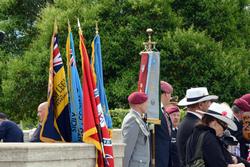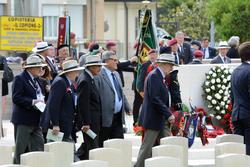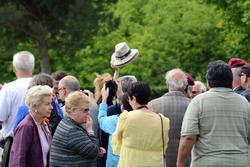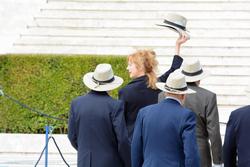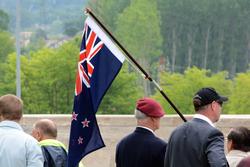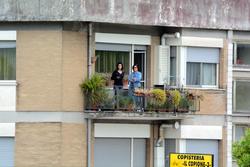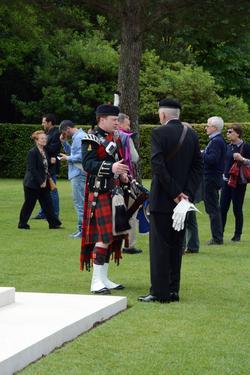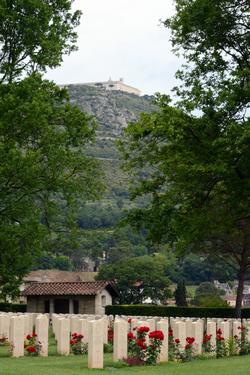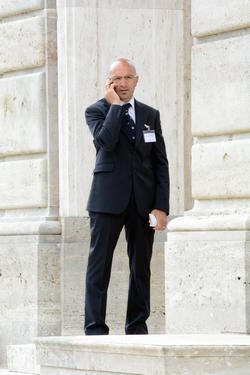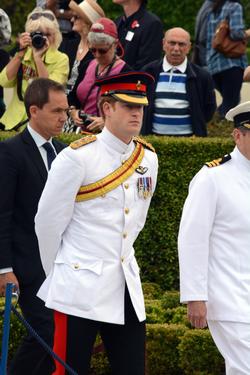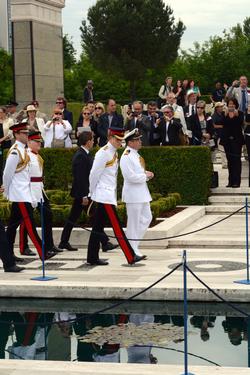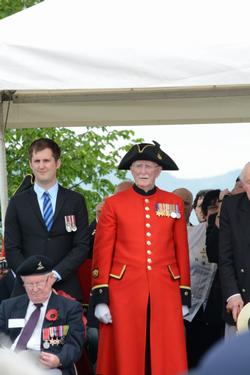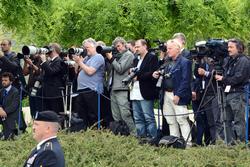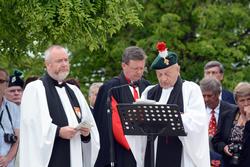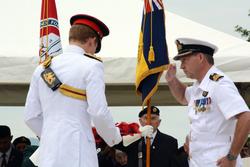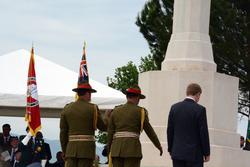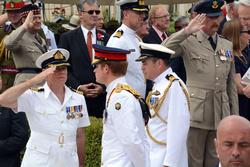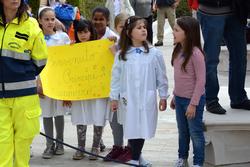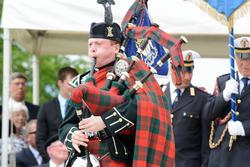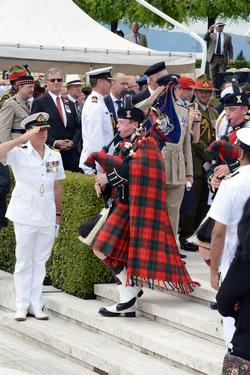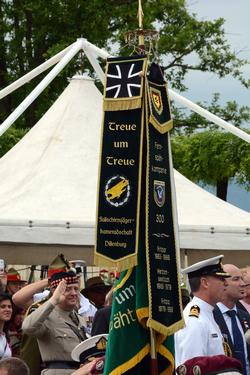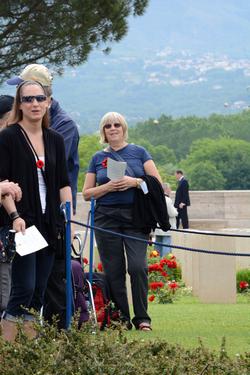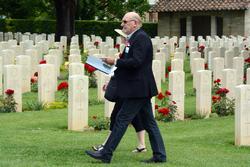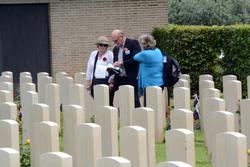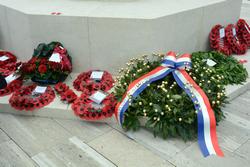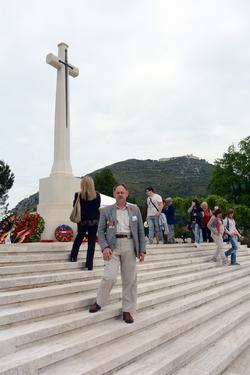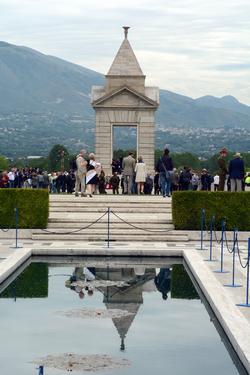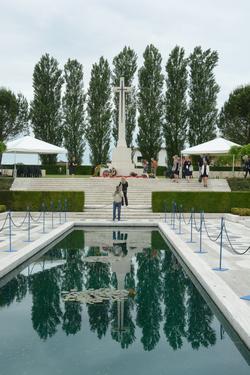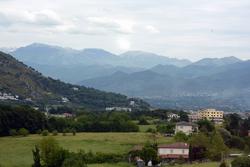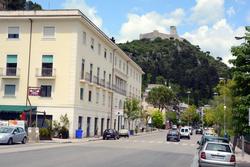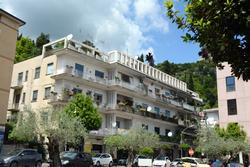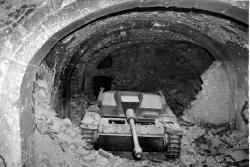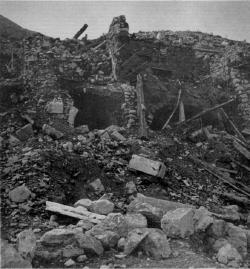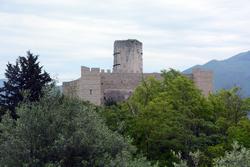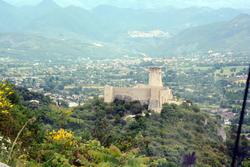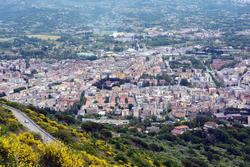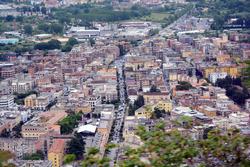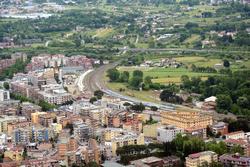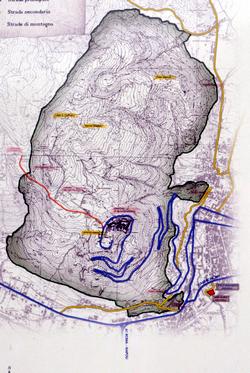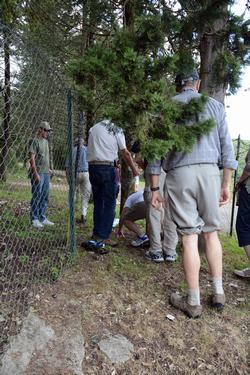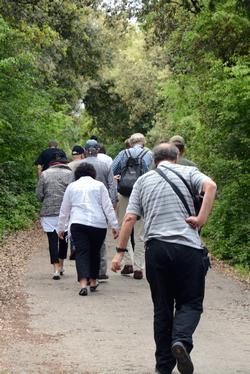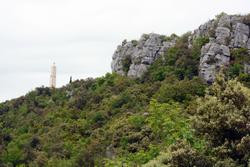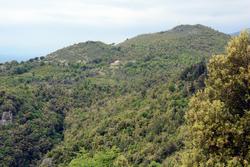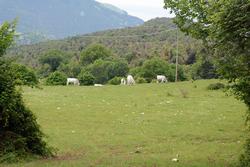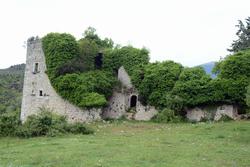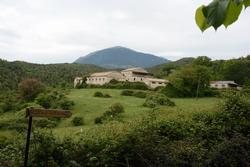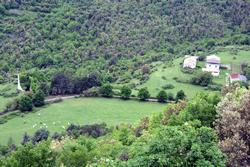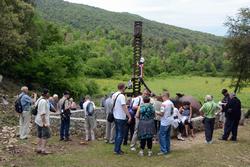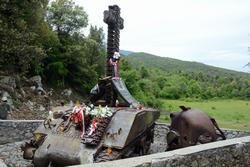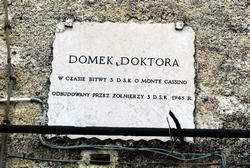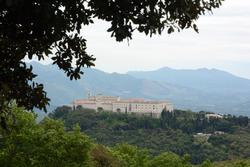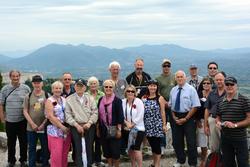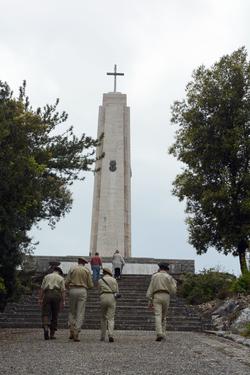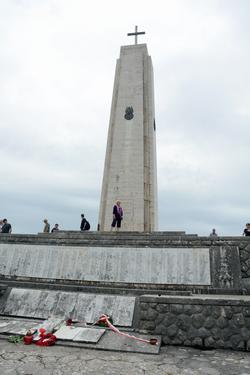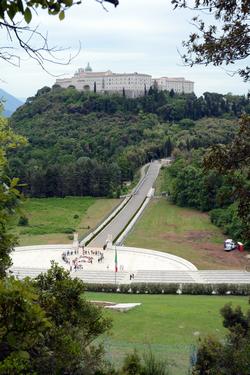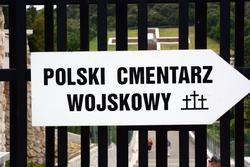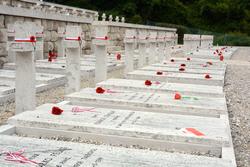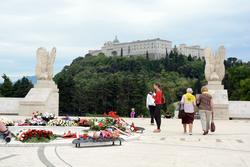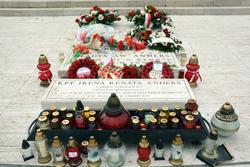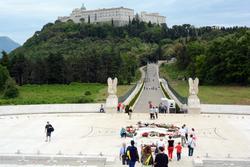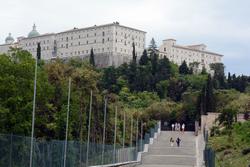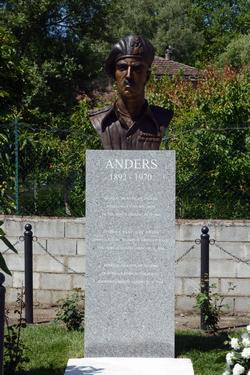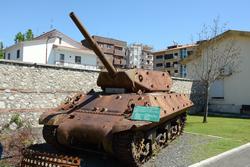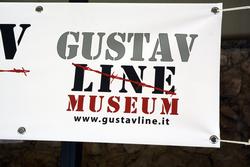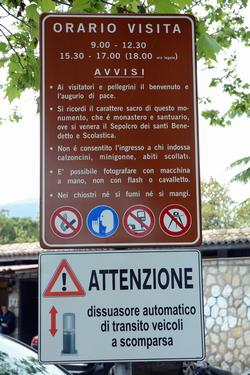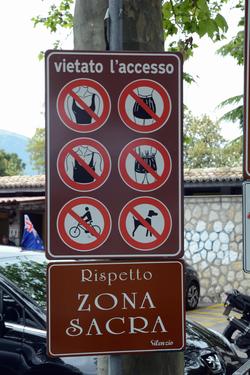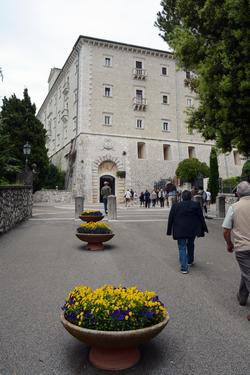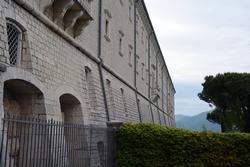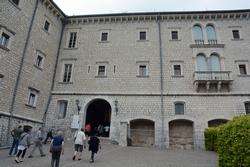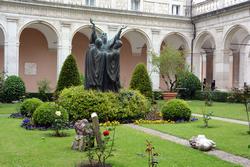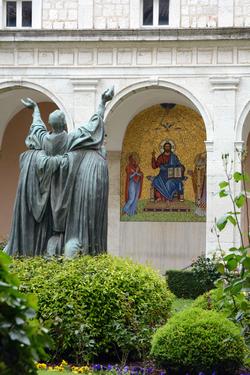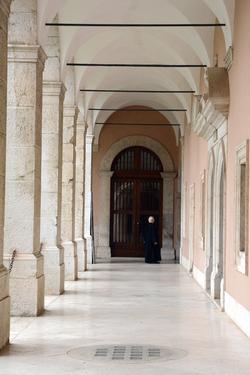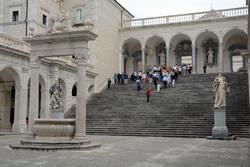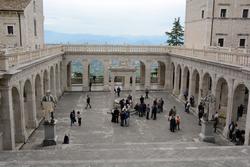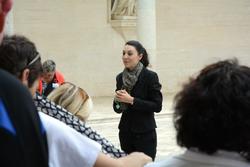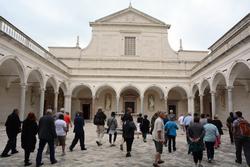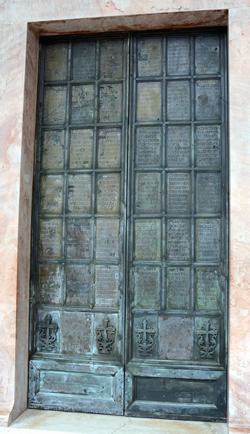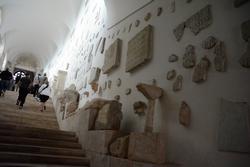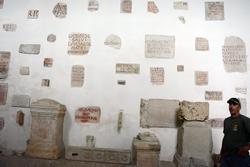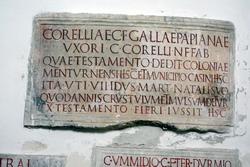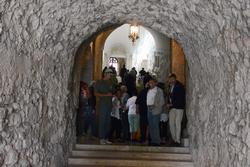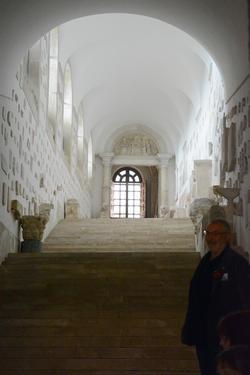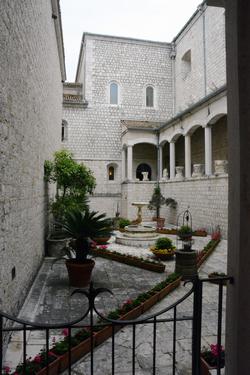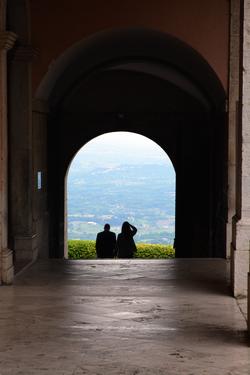Europe 14 - Day 24
Cassino Commemoration Day 6: The International Service, Albaneta Farm, the Polish Cemetery and a visit to the Abbey
Monday was now the date for the main international service. It was organised and run by the British (it was their turn).
The star attraction was again Prince Harry and security was even more evident than at the NZ service the previous day.
In the afternoon we then headed up the steep winding road to the
Abbey of Monte Cassino, stopping to admire the view and to imagine how easily the German defenders were able to see any
movement in the town 70 years ago. We then walked up the farm road behind the Abbey to Albaneta Farm,
returning to visit the Polish War Cemetery, before entering the Abbey for our guided tour.
The International Service at Cassino
The British excel at pomp and ceremony, with band, trumpets and bagpipes.
However, they did make it rather difficult for the assembled people to sing the second hymn "Abide With Me" - when they had laid the words out
incorrectly in the programme booklet (see the Order of Service page 6). The band
was also confused, stopping after three verses, whereas four had been printed in the programme.
Wreaths were laid and 2 minutes silence observed. Two minutes of silence (it was actually 2 minutes and 25 seconds) is a long time when you are
standing in the hot sun. At about this point in the proceedings we were joined at the side of the crowd near the front by a group of Italian girls.
They were only 4-5 years old and they were
very excited, chattering like a flock of chickens. They were holding a large yellow banner that they were keen for Prince Harry to read.
Unfortunately the Prince walked off the wrong way and they had to rush around to
catch his attention. Fortunately, the noise rushed off with them.
|
The Colours from many regiments are waiting to march in.
|
The NZ Veterans arrive and are soon mixed into the large crowd.
|
But Sandy has the answer: "Follow these hats" she called.
|
|
And you could see the hats over the crowd. But a few veterans were lost on the way.
|
Mark with the NZ Flag was easier to find.
|
Even the neighbours in the apartment block across the road were out with their camera.
|
|
This time, a professional piper!
|
The Abbey of course had the best view.
|
Security was tight again. Something is up, he got quite excited.
|
|
Sure enough, Prince Harry had arrived.
|
There were more uniforms this time.
|
And a Chelsea Pensioner.
|
|
The two pipers led the official party past the Reflecting Pool.
|
And into the barrage from the press photographers.
|
The Service was underway...
|
|
and wreaths were laid.
|
The NZ wreath was laid by the Minister of Defence.
|
Then it was over, and the Prince departed.
|
|
To be chased by the chattering girls...
|
and their welcoming banner.
|
The pipers led the way...
|
|
to a smart salute...
|
and the regimental colours, also saluted.
|
While the crowds watched a colourful display.
|
|
People then dispersed into the cemetery, searching for names...
|
and finding names and memories.
|
There were many wreaths.
|
|
The Cross with the Monastery in the background.
|
Finally, the crowds departed,...
|
leaving the Reflecting Pool all calm again.
|
The road to Monte Cassino
In the afternoon we headed back into Cassino and turned off Highway 6 next to the old Hotel des Roses. Here the road climbs steeply
up the side of Monte Cassino towards the Abbey. We paused on the way up to look out over Cassino town.
|
Early morning view of the hills behind Monte Cassino, showing the rugged terrain.
|
The rebuilt Hotel des Roses, scene of fierce resistance by the German forces.
|
The rebuilt Continental Hotel, also fiercely contested.
|
|
The German Stug self-propelled gun inside the Hotel Continental.
|
|
The ruins of the Continental Hotel.
|
|
Part way up the hill is the spur known as Castle Hill.
|
View of Castle Hill from higher up the road.
|
Towards the top of the hill, the road sweeps back to give a clear view of the town.
|
|
Another view point, this time lookking straight dowm part of Highway 6.
|
A cropped part of the previous photo showing how easy it was for the Germans to see people moving around.
|
Cassino Railway Station, with the river and rough ground behind, that the Maori Battalion fought through in 1944.
|
Albaneta Farm
The ground behind the Abbey was known as Albaneta Farm. The farm buildings were destroyed by artillery and aerial bombing as part of an attempt to capture the Abbey from the rear. It was
also the point where the Cavendish Road emerged onto the ridge. This road had been built by New Zealand engineers as a tank route to the top, without
attracting the attention of the Germans. A Polish tank unit climbed the road and caught the Germans by surprise, but the attack had been commenced before the infantry were
ready, allowing the Germans time to recover and damage the tanks. The leading tank was left behind and was blown apart by the Germans. Is still there today, a memorial to the dedicated Poles.
|
Map of the area on the noticeboard at the start of the track to Albaneta Farm. The track is the orange line leading northwest from near the Abbey.
|
There is a locked gate beside the noticeboard, so people usually climb through a hole in the fence...
|
But Greg, our tour leader, forgot to check the gate - it was unlocked this time so the rest of us just walked through!
|
|
Rocky outcrops show the rough terrain, with the Polish memorial on the top of Point 595.
|
Albaneta Farm can be seen in the distance. The deep ravine in the forground was the route taken by the Germans to resupply
their forces in the area of the Abbey.
|
Today, cows graze in the fields.
|
|
The remains of the Albaneta Farm buildings destroyed in 1944.
|
The rebuilt farm.
|
View from near the top of the hill, with the farm on the right and the destroyed remains on the left.
|
|
Just beyond the farm is the Polish Tank Memorial. This was the lead Polish tank, disabled and later destroyed by the Germans.
|
The Polish Tank Memorial.
|
The Sherman tank complete with broken tracks and extra armour welded on the sides.
|
|
The "Doctor's House" also forms part of the Polish memorial.
|
View of the Abbey from the top of Point 595
|
Our tour group at the summit.
|
|
A group of Polish soldiers approaches the Memorial to the Missing.
|
The list of names of the missing Polish soldiers.
|
Below the Abbey lies the Polish War Cemetery.
|
The Polish War Cemetery
The Polish Army under General Anders was determined to leave their mark at Cassino. Not only were they determined to fight the German Army, they
believed that to do so and to gain glory at Cassino would guarantee them the right to a free Poland after the war. They fought hard, suffered great casualties
and eventually had the honour of capturing the Abbey as the German Army was withdrawing. Unfortunately all this was not sufficient, and Poland was traded away
for other gains in Europe as the war came to a close.
Over 2,000 graves lie in the Cemetery in the saddle of the hill behind the Abbey. The site had undergone renovation and all graves had been cleaned in
preparation for the 70th commemoration. The event was also the opportunity to unveil memorials to General Anders and his wife, who are buried here. There is
also a new statue of him at the remodelled museum in Cassino town.
|
|
View from the entrance gates towards the Polish Cemetery.
|
Looking along a line of graves, decorated with the red and white colours of Poland.
|
|
Flowers on the central part of the Cemetery.
|
The graves and memorials for General Anders and his wife.
|
Closer view of the Anders graves.
|
|
View from the centre of the cemetery towards the Abbey.
|
The Abbey above the entrance path.
|
The memorial to General Anders at the Gustav Line Museum in central Cassino.
|
|
The bronze bust of Anders.
|
Closer view with Monte Cassino rising in the background.
|
The view of Monte Cassino and Castle Hill from the Anders memorial.
|
|
An M10 tank used by the Polish Forces.
|
|
Brochure for the photograph exhibition by Maree Wilks of the 2004 Veterans Commemorations
|
The Abbey of Monte Cassino
Much has been written about the Abbey that dominates the skyline above Cassino town. It had been destroyed three times in its long history but it the last
occasion that everybody remembers and argues about. Who ordered its destruction? What was the point? Was there any evidence that the Germans were using it as part of
their defence of the town? The arguments are irrelevent. The Abbey formed a high, strong point and was an integral part of the German Gustav Line, making it part of that military installation.
The Abbey was rebuilt after the war, for the third time in its history. The work was sponsored by the Italian Government, but many other countries, including New Zealand, contributed.
|
Signs near the entrance to the Abbey.
|
More of the "Do not..." variety.
|
Pathway up to the entrance.
|
|
Looking up along the high walls
|
The main visitor entrance.
|
The entrance cloister.
|
|
The bronze sculpture by A. Selva of St Benedict being supported by two monks. The statue was a gift to the Abbey
from the German Chancellor K. Adenauer in 1952.
|
Portrait of St Benedict.
|
The cloisters near the entrance.
|
|
Looking up the steps of the main courtyard...
|
And looking down the same steps.
|
Our local guide for our tour of the Abbey.
|
|
Walking through the courtyard outside the basilica where we heard Whakaria Mai being sung.
|
Inside the basilica during the service for the NZ Veterans.
|
Example of the detail in the ceiling of the basilica
|
|
The bronze door to the basilica, dating from the 11th century. It was made in Constantinople in 1066 AD.
|
One of the stained glass windows from the Chapel of St Martin. They were produced in 1989 by Isabel Fisher. This window
was sponsored by New Zealand.
|
The kneeling stone. The depression in the stone is in the shape of the cast of a kneeling or reclining person.
|
|
The gallery wall containing fragments from the old Abbey
|
|
|
|
Our group in one of the stairways.
|
Some of the Renaissance artwork saved from the destruction of the Abbey.
|
A piece of detailed tapestry from the old Abbey.
|
|
Now on our way out, up the stairs...
|
through the small courtyard....
|
and out through the door, looking down on the town of Cassino and the Liri Valley.
|
Return to top of page
Back to previous day
 ---------
---------
 Forward to next day
Forward to next day
Return
to Trip Index
Last
updated: 26/10/2014
|
